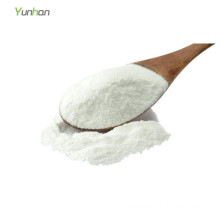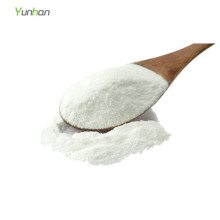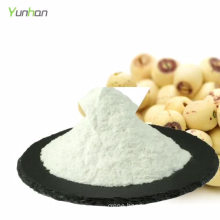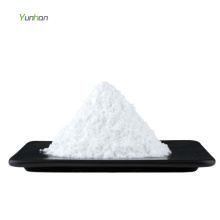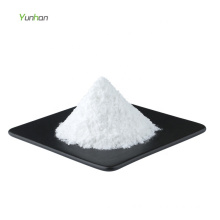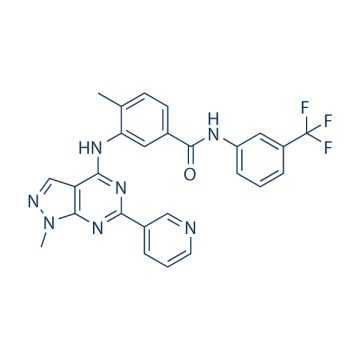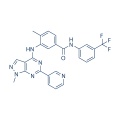NVP-BHG712 940310-85-0
Product Description
.cp_wz table {border-top: 1px solid #ccc;border-left:1px solid #ccc; } .cp_wz table td{border-right: 1px solid #ccc; border-bottom: 1px solid #ccc; padding: 5px 0px 0px 5px;} .cp_wz table th {border-right: 1px solid #ccc;border-bottom: 1px solid #ccc; padding: 5px 0px 0px 5px;}
Molecular Weight:
503.48 NVP-BHG712 is a Specific EPHB4 Inhibitor with ED50 of 25 nM that discriminates between VEGFR and EphB4 inhibition; also shows activity against c-Raf, c-Src and c-Abl with IC50 of 0.395 μM, 1.266 μM and 1.667 μM, respectively.
Biological Activity
NVP-BHG712 treatment also dose dependently leads to the inhibition of
RTK autophosphorylation in stable transfected A375 melanoma cells with
EC50 of 25 nM and 4.2 μM for EphB4 and VEGFR2, respectively.
In a growth factor-induced Angiogenesis model, NVP-BHG712 (3 mg/kg, p.o)
significantly suppresses VEGF stimulated tissue formation and
vascularization by inhibiting EphB4 forward signaling. Furthermore,
NVP-BHG712 (10 mg/kg/kg, p.o.) potently reverses VEGF enhanced tissue
formation and vessel growth. NVP-BHG712 (3 mg/kg, p.o.) shows a long
lasting exposure with concentrations around 10 μM in plasma as well as
in lung and liver tissue for up to 8 hours, and thus results in a long
lasting inhibition of EphB4 kinase activity in mice.
In vitro kinase assays
All in vitro kinase assays are performed with recombinant purified
kinases either purchased from external vendors or produced in house. To
estimate kinase activity both, TR-FRET-based LanthaScreenTM and Caliper mobility shift are used. In brief, the LanthaScreenTM assay technology is based on the discrimination between the
unphosphorylated substrate and the phosphorylated product by a
phospho-specific antibody, binding only to the phosphorylated version of
the substrate. Both, antibody and substrate, carry fluorescent labels
and the close proximity of the labels in the formed complex allows the
measurement of a fluorescence resonance energy transfer (FRET) signal.
Reading of the FRET signal in a time-dependent/time-gated manner further
improves the assay performance by reducing background fluorescence. For
dose–response measurements NVP-BHG712 is pre-diluted in 90% DMSO and 50
nL of compound solutions are dispensed directly into the empty assay
plate using a HummingBird nanodispenser. The kinase reactions are
started by addition of 4.5 μL ATP solution (4 μM ATP, 20 mM Tris/HCL, 1
mM DTT, 0.03% Tween20, 0.01 mM Na3VO4) and 4.5 μL
enzyme/substrate mix (100 nM fluorescein poly-GAT), 0.5% bovine serum
albumin, 20 mM Tris/HCL, 1 mM DTT, 0.03% Tween20, 0.01 mM Na3VO4).
Further components of the enzyme/substrate mix are the enzymes as well as MgCl2/MnCl2
which are adjusted specifically to the requirements of the individual
enzyme. After incubation for 60 minutes at r.t. the kinase reactions are
stopped by addition of 4.5 μL stop solution (50 mM EDTA pH 8.0, 0.04%
NP-40, 20 mM Tris/HCl pH 7.4) followed by 4.5 μL of detection mix (1.72
μg/mL Tb-PY20 antibody), 1% bovine serum albumin, 20 mM Tris/HCl, 1 mM
DTT, 0.03% Tween20, 0.01 mM Na3VO4).
After incubation for 45 minutes at
r.t. plates are analyzed in a BMG PHERAstar plate reader. In the Caliper
mobility shift assays kinase reactions are analyzed by microfluidic
capillary electrophoresis. The transfer of phosphate from ATP to a short
peptide by a kinase causes a change in the net-charge of the peptide by
−2.
The charge difference between the unphosphorylated and
phosphorylated entities of the peptide can be separated in an electrical
field. Using peptides attached with a fluorescent label allows
detection and quantification of both forms and hence the calculation of
the reaction turnover. For dose–response measurements NVP-BHG712 is
pre-diluted in 90% DMSO and 50 nL aliquots of solution are dispensed
directly into the empty assay plate using a HummingBird nanodispenser.
The kinase reactions are started by addition of 4.5 μL substrate mix
consisting of ATP and peptide substrate in assay buffer (50 mM HEPES pH
7.5, 0.02% bovine serum albumin, 1 mM DTT, 0.02% Tween20, 0.01 mM Na34,
10 mM beta-glycerophosphate) and 4.5 μL enzyme solution in assay
buffer. The peptide concentration is 2 μM in the assays. Concentrations
for the enzyme, as well as for MgCl2 and MnCl2 are
adjusted specifically to the requirements of the individual enzyme.
ATP
concentrations are adjusted to the Km values of the specific enzyme.
After incubation for 60 minutes at 30 °C the kinase reactions are
stopped by addition of 16 μL stop solution (100 mM HEPES pH 7.5, 5%
DMSO, 0.1% coating reagent 10 mM EDTA pH 8.0, 0.015% BRIJ35). Stopped
kinase reactions are analyzed in a LC3000 reader.
Contact us if you need more details on 940310-85-0. We are ready to answer your questions on packaging, logistics, certification or any other aspects about NVP-BHG712 940310-85-0、940310-85-0 NVP-BHG712. If these products fail to match your need, please contact us and we would like to provide relevant information.
Molecular Weight:
503.48 NVP-BHG712 is a Specific EPHB4 Inhibitor with ED50 of 25 nM that discriminates between VEGFR and EphB4 inhibition; also shows activity against c-Raf, c-Src and c-Abl with IC50 of 0.395 μM, 1.266 μM and 1.667 μM, respectively.
Biological Activity
NVP-BHG712 treatment also dose dependently leads to the inhibition of
RTK autophosphorylation in stable transfected A375 melanoma cells with
EC50 of 25 nM and 4.2 μM for EphB4 and VEGFR2, respectively.
In a growth factor-induced Angiogenesis model, NVP-BHG712 (3 mg/kg, p.o)
significantly suppresses VEGF stimulated tissue formation and
vascularization by inhibiting EphB4 forward signaling. Furthermore,
NVP-BHG712 (10 mg/kg/kg, p.o.) potently reverses VEGF enhanced tissue
formation and vessel growth. NVP-BHG712 (3 mg/kg, p.o.) shows a long
lasting exposure with concentrations around 10 μM in plasma as well as
in lung and liver tissue for up to 8 hours, and thus results in a long
lasting inhibition of EphB4 kinase activity in mice.
In vitro kinase assays
All in vitro kinase assays are performed with recombinant purified
kinases either purchased from external vendors or produced in house. To
estimate kinase activity both, TR-FRET-based LanthaScreenTM and Caliper mobility shift are used. In brief, the LanthaScreenTM assay technology is based on the discrimination between the
unphosphorylated substrate and the phosphorylated product by a
phospho-specific antibody, binding only to the phosphorylated version of
the substrate. Both, antibody and substrate, carry fluorescent labels
and the close proximity of the labels in the formed complex allows the
measurement of a fluorescence resonance energy transfer (FRET) signal.
Reading of the FRET signal in a time-dependent/time-gated manner further
improves the assay performance by reducing background fluorescence. For
dose–response measurements NVP-BHG712 is pre-diluted in 90% DMSO and 50
nL of compound solutions are dispensed directly into the empty assay
plate using a HummingBird nanodispenser. The kinase reactions are
started by addition of 4.5 μL ATP solution (4 μM ATP, 20 mM Tris/HCL, 1
mM DTT, 0.03% Tween20, 0.01 mM Na3VO4) and 4.5 μL
enzyme/substrate mix (100 nM fluorescein poly-GAT), 0.5% bovine serum
albumin, 20 mM Tris/HCL, 1 mM DTT, 0.03% Tween20, 0.01 mM Na3VO4).
Further components of the enzyme/substrate mix are the enzymes as well as MgCl2/MnCl2
which are adjusted specifically to the requirements of the individual
enzyme. After incubation for 60 minutes at r.t. the kinase reactions are
stopped by addition of 4.5 μL stop solution (50 mM EDTA pH 8.0, 0.04%
NP-40, 20 mM Tris/HCl pH 7.4) followed by 4.5 μL of detection mix (1.72
μg/mL Tb-PY20 antibody), 1% bovine serum albumin, 20 mM Tris/HCl, 1 mM
DTT, 0.03% Tween20, 0.01 mM Na3VO4).
After incubation for 45 minutes at
r.t. plates are analyzed in a BMG PHERAstar plate reader. In the Caliper
mobility shift assays kinase reactions are analyzed by microfluidic
capillary electrophoresis. The transfer of phosphate from ATP to a short
peptide by a kinase causes a change in the net-charge of the peptide by
−2.
The charge difference between the unphosphorylated and
phosphorylated entities of the peptide can be separated in an electrical
field. Using peptides attached with a fluorescent label allows
detection and quantification of both forms and hence the calculation of
the reaction turnover. For dose–response measurements NVP-BHG712 is
pre-diluted in 90% DMSO and 50 nL aliquots of solution are dispensed
directly into the empty assay plate using a HummingBird nanodispenser.
The kinase reactions are started by addition of 4.5 μL substrate mix
consisting of ATP and peptide substrate in assay buffer (50 mM HEPES pH
7.5, 0.02% bovine serum albumin, 1 mM DTT, 0.02% Tween20, 0.01 mM Na34,
10 mM beta-glycerophosphate) and 4.5 μL enzyme solution in assay
buffer. The peptide concentration is 2 μM in the assays. Concentrations
for the enzyme, as well as for MgCl2 and MnCl2 are
adjusted specifically to the requirements of the individual enzyme.
ATP
concentrations are adjusted to the Km values of the specific enzyme.
After incubation for 60 minutes at 30 °C the kinase reactions are
stopped by addition of 16 μL stop solution (100 mM HEPES pH 7.5, 5%
DMSO, 0.1% coating reagent 10 mM EDTA pH 8.0, 0.015% BRIJ35). Stopped
kinase reactions are analyzed in a LC3000 reader.
Contact us if you need more details on 940310-85-0. We are ready to answer your questions on packaging, logistics, certification or any other aspects about NVP-BHG712 940310-85-0、940310-85-0 NVP-BHG712. If these products fail to match your need, please contact us and we would like to provide relevant information.
Product Categories : Protein Tyrosine Kinase > Ephrin Receptor Inhibitor
Other Products
Hot Products
Astragaloside AChlortetracycline HCl 64-72-2Paclitaxel 33069-62-4Dexamethasone Acetate 1177-87-3Dinaciclib (SCH727965) 779353-01-4CHIR-124 405168-58-3Ro3280 1062243-51-9TAME 901-47-3CCG-1423 285986-88-110058-F4 403811-55-2Dabigatran (BIBR 953) 211914-51-1H 89 2HCl 130964-39-5T0901317 293754-55-9Aprepitant 170729-80-3Turofexorate Isopropyl (XL335) 629664-81-9BMS-378806 357263-13-9


